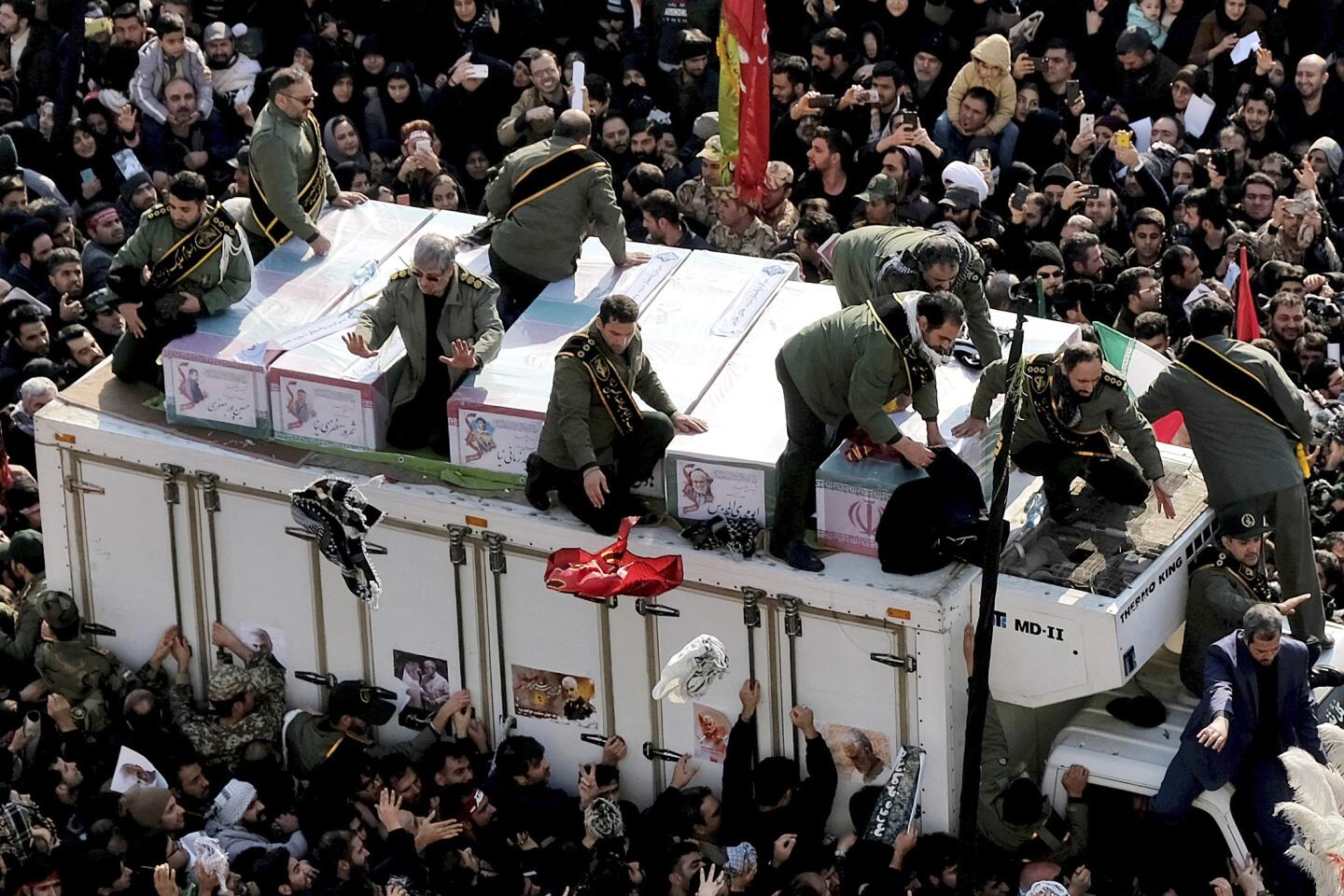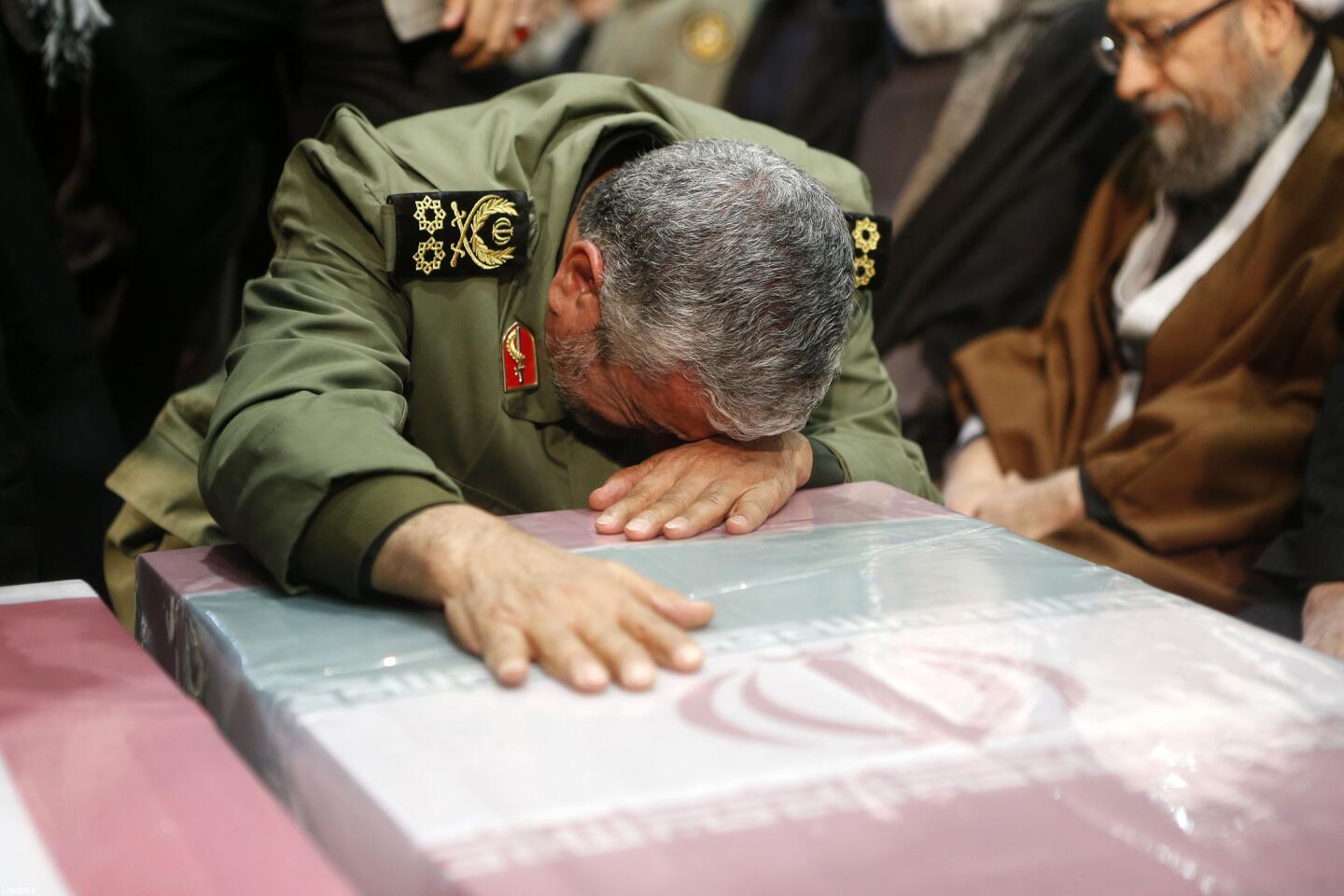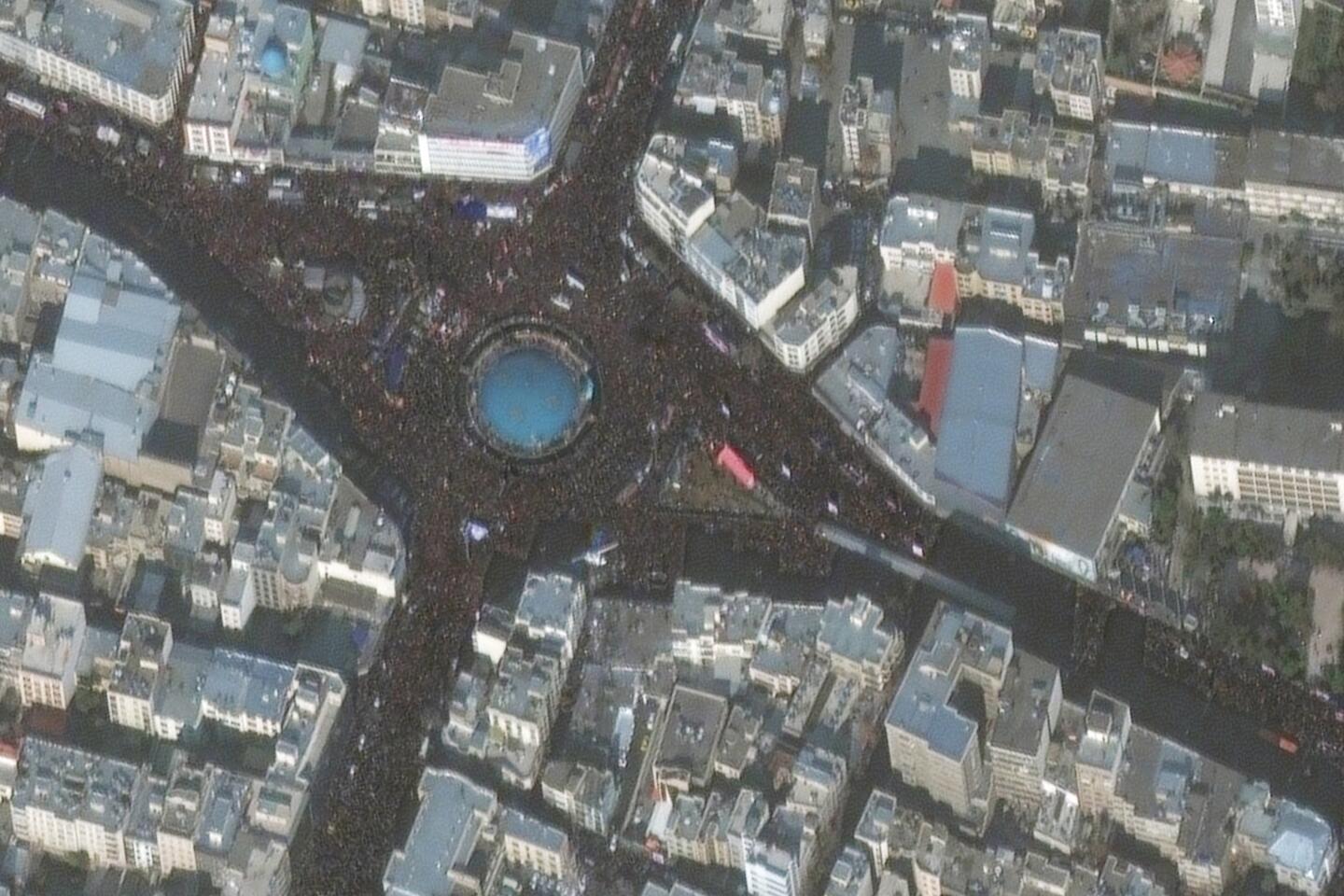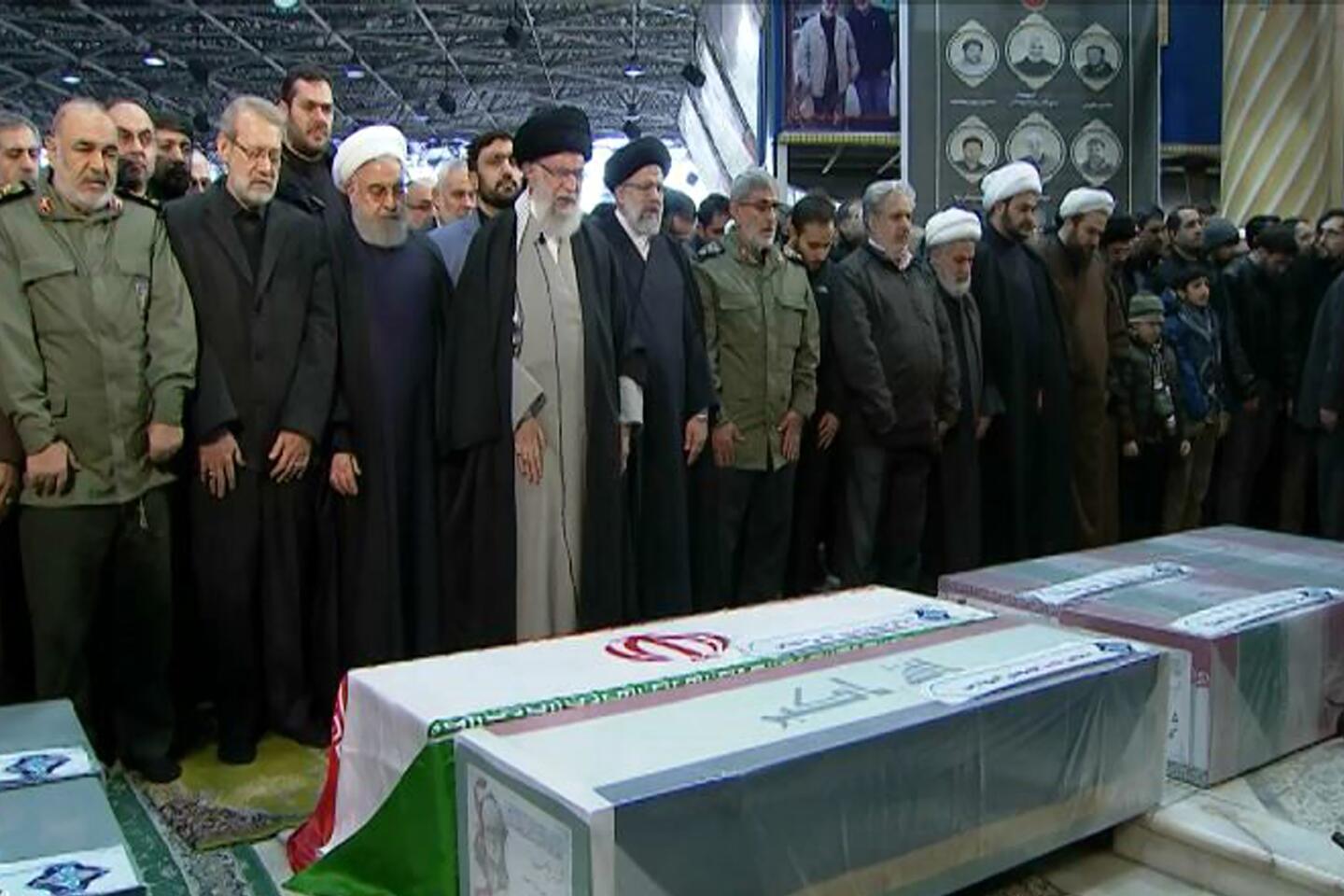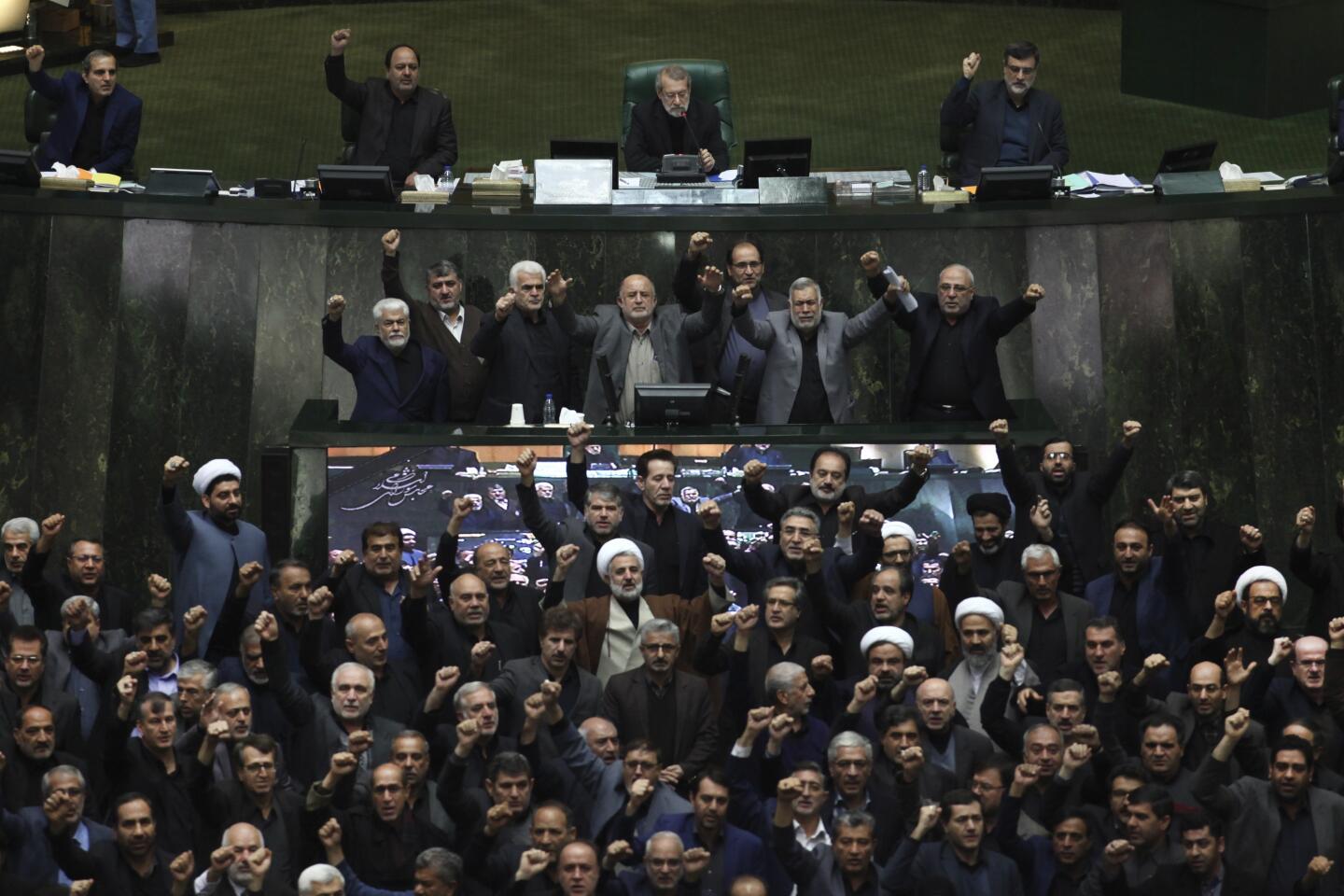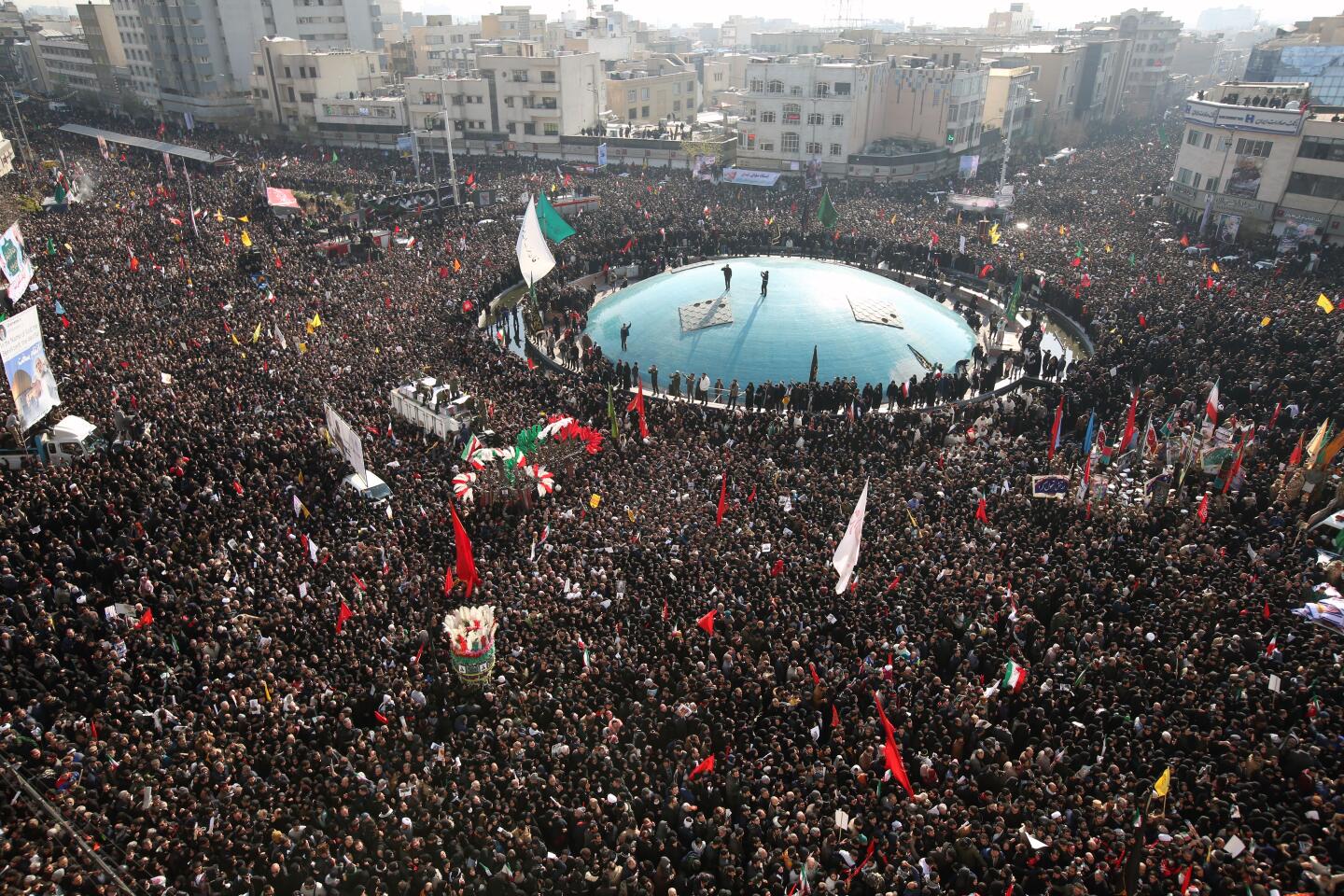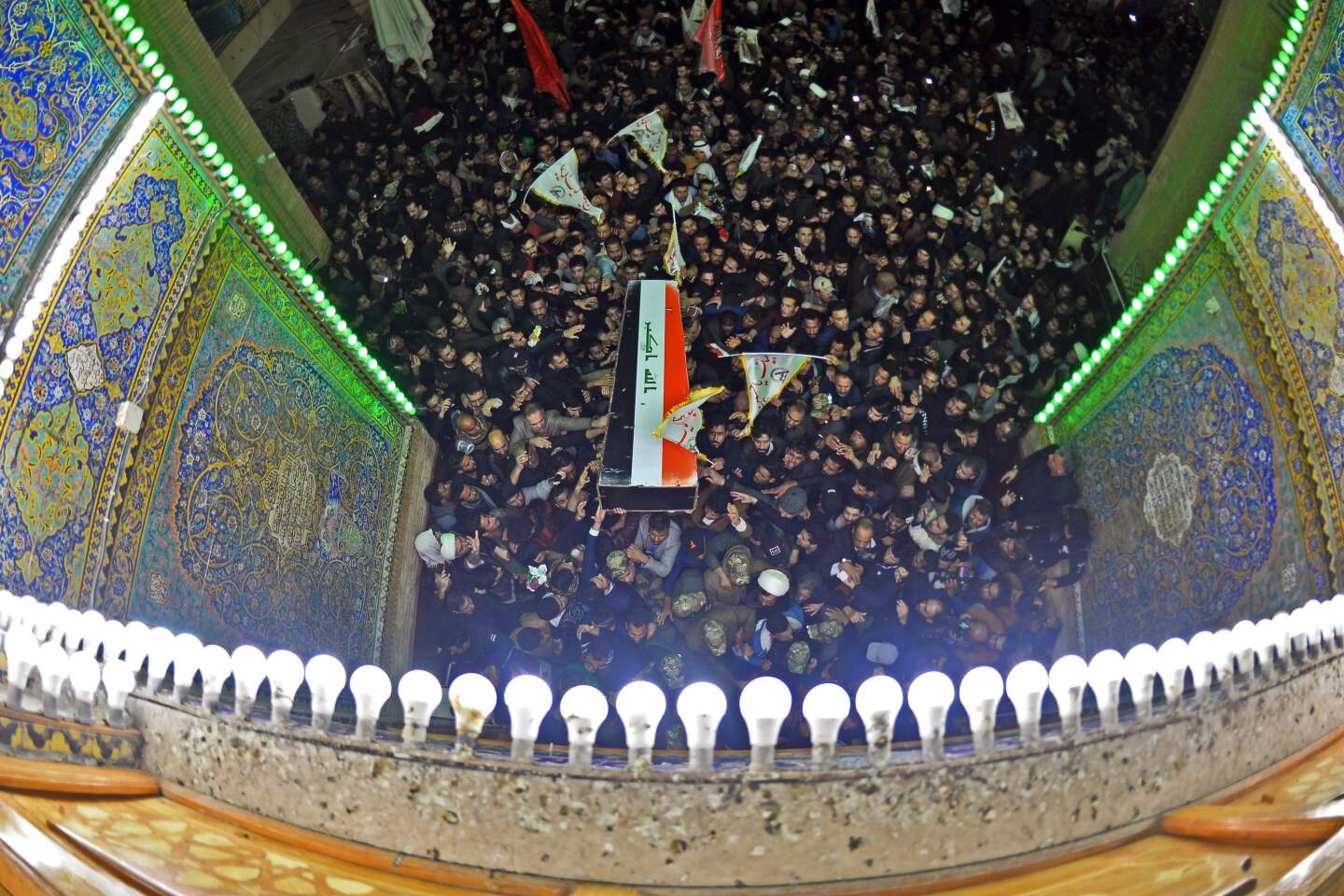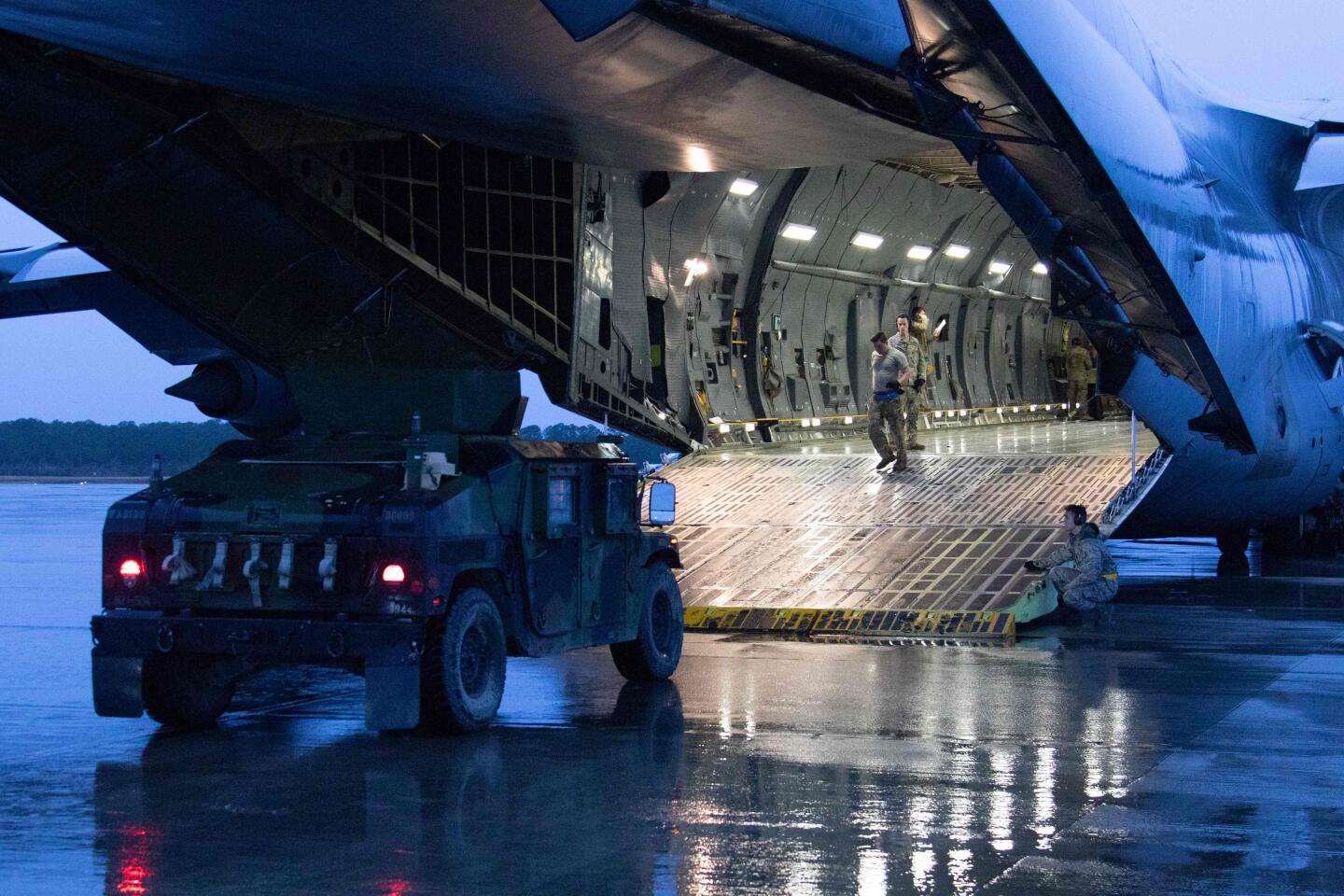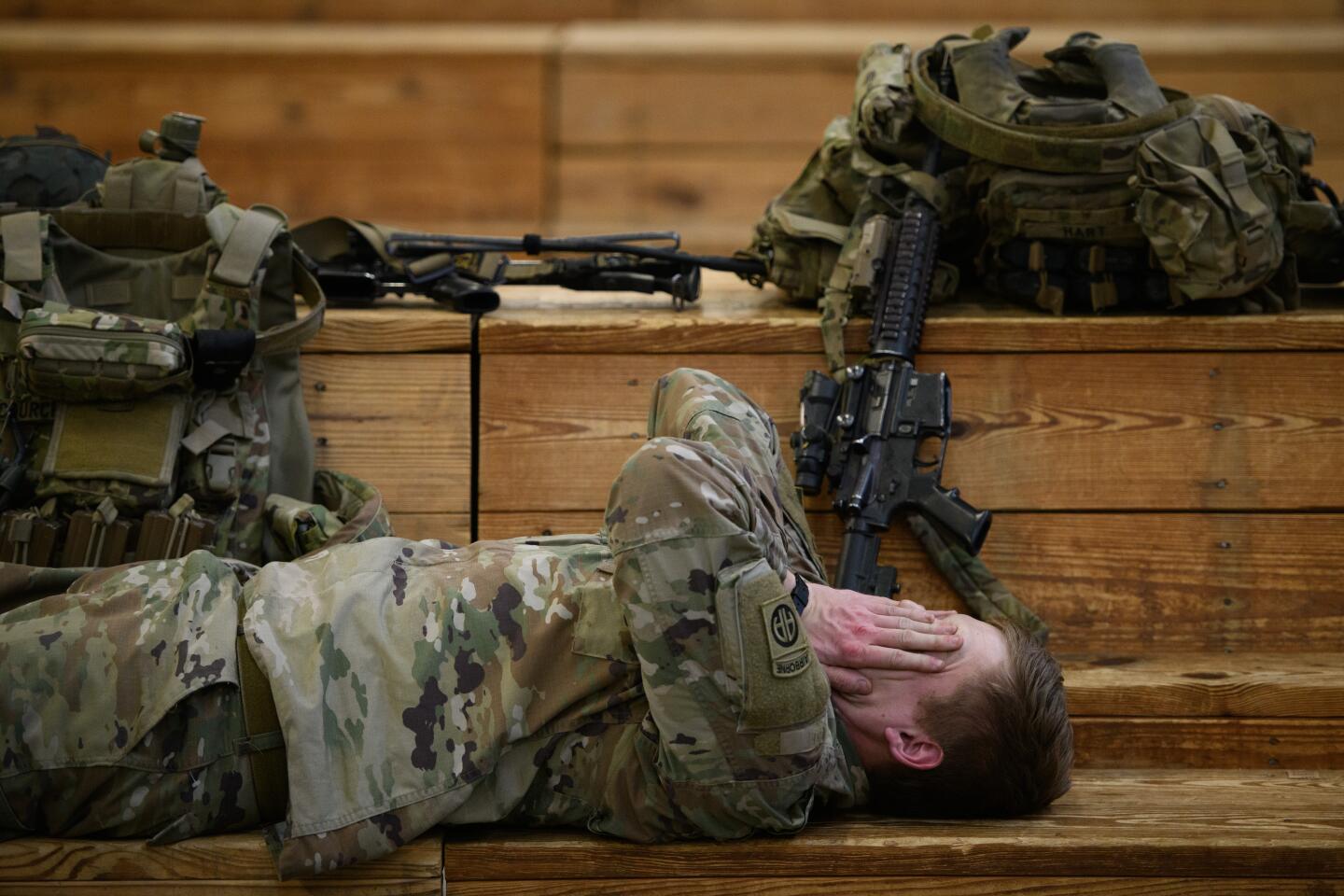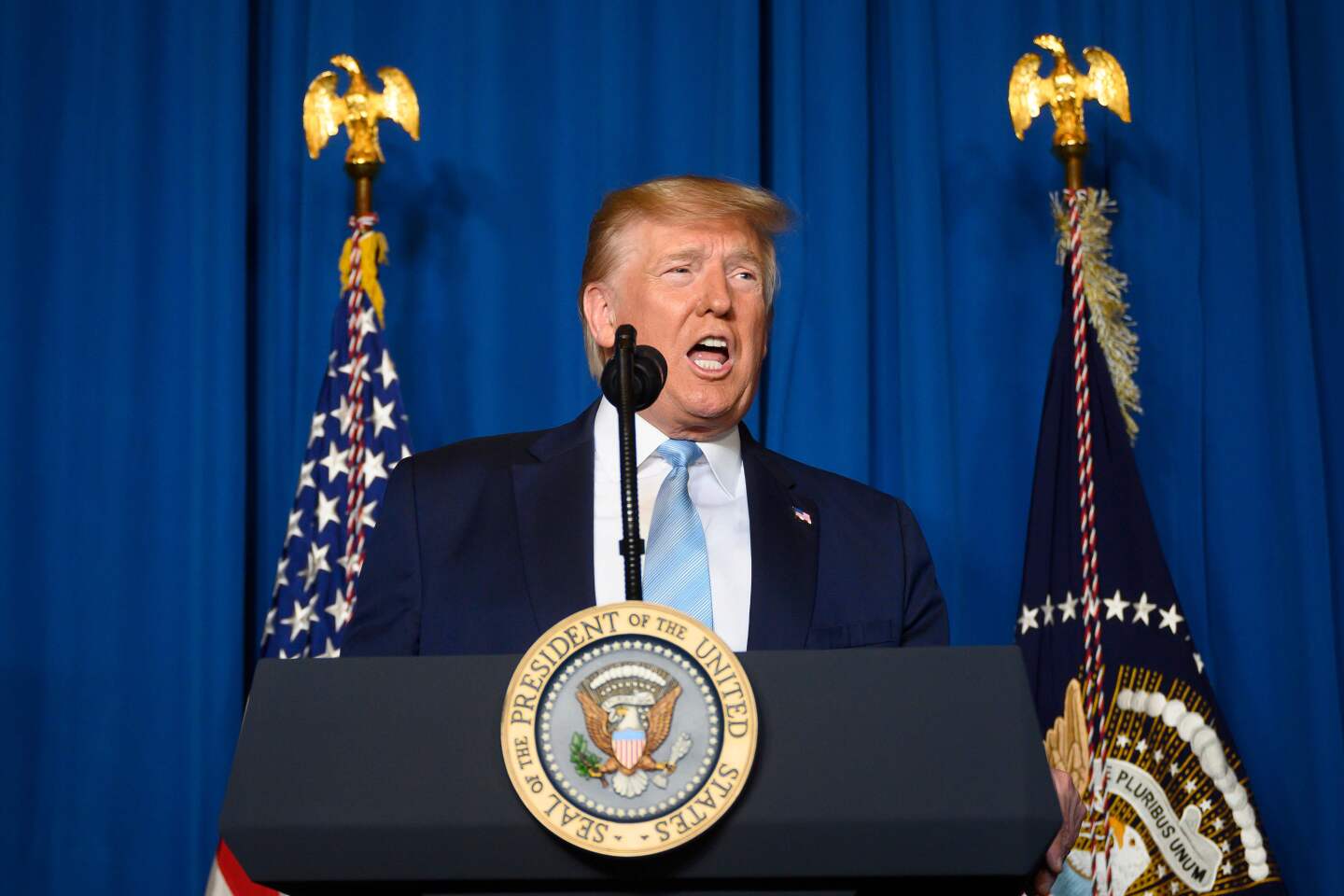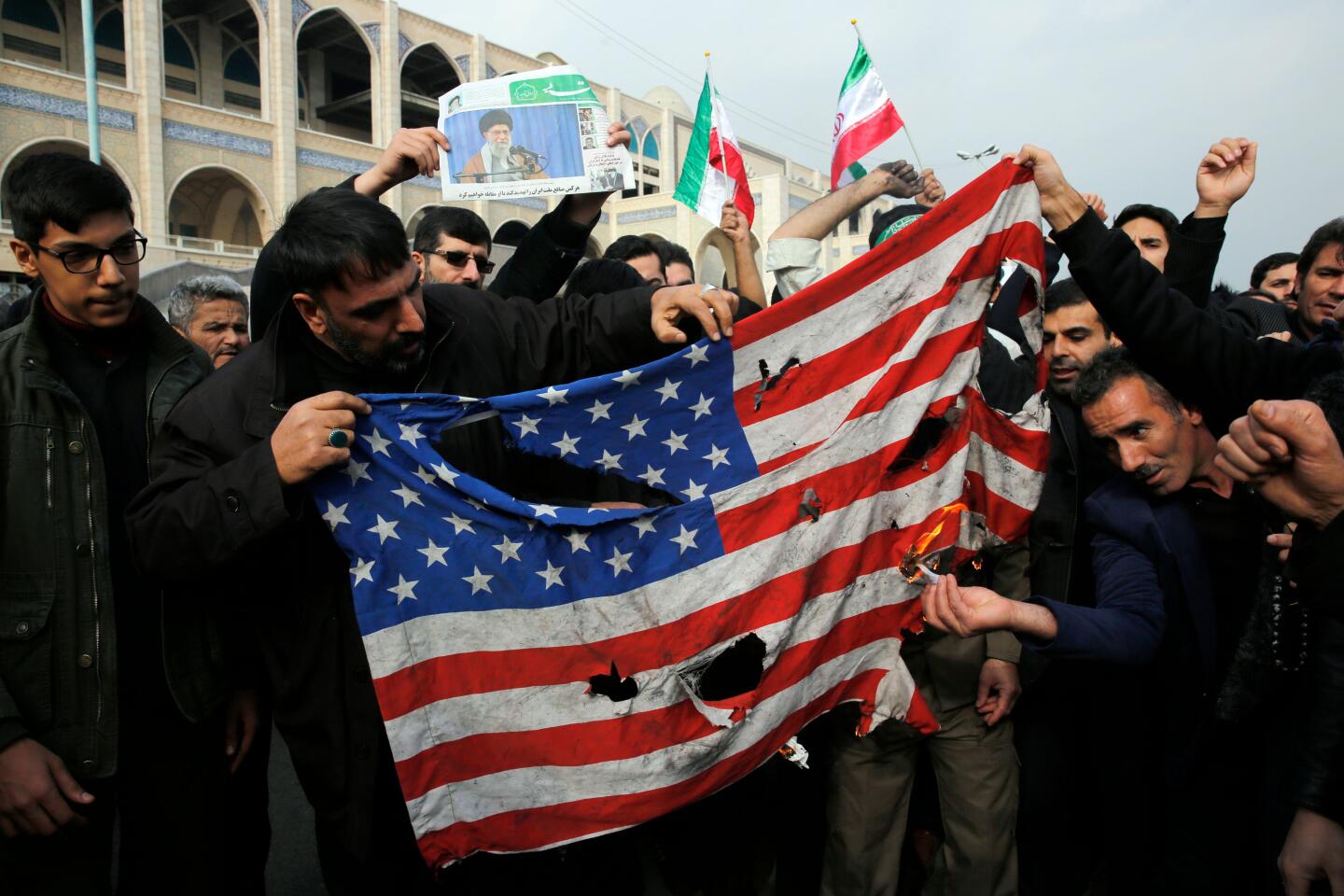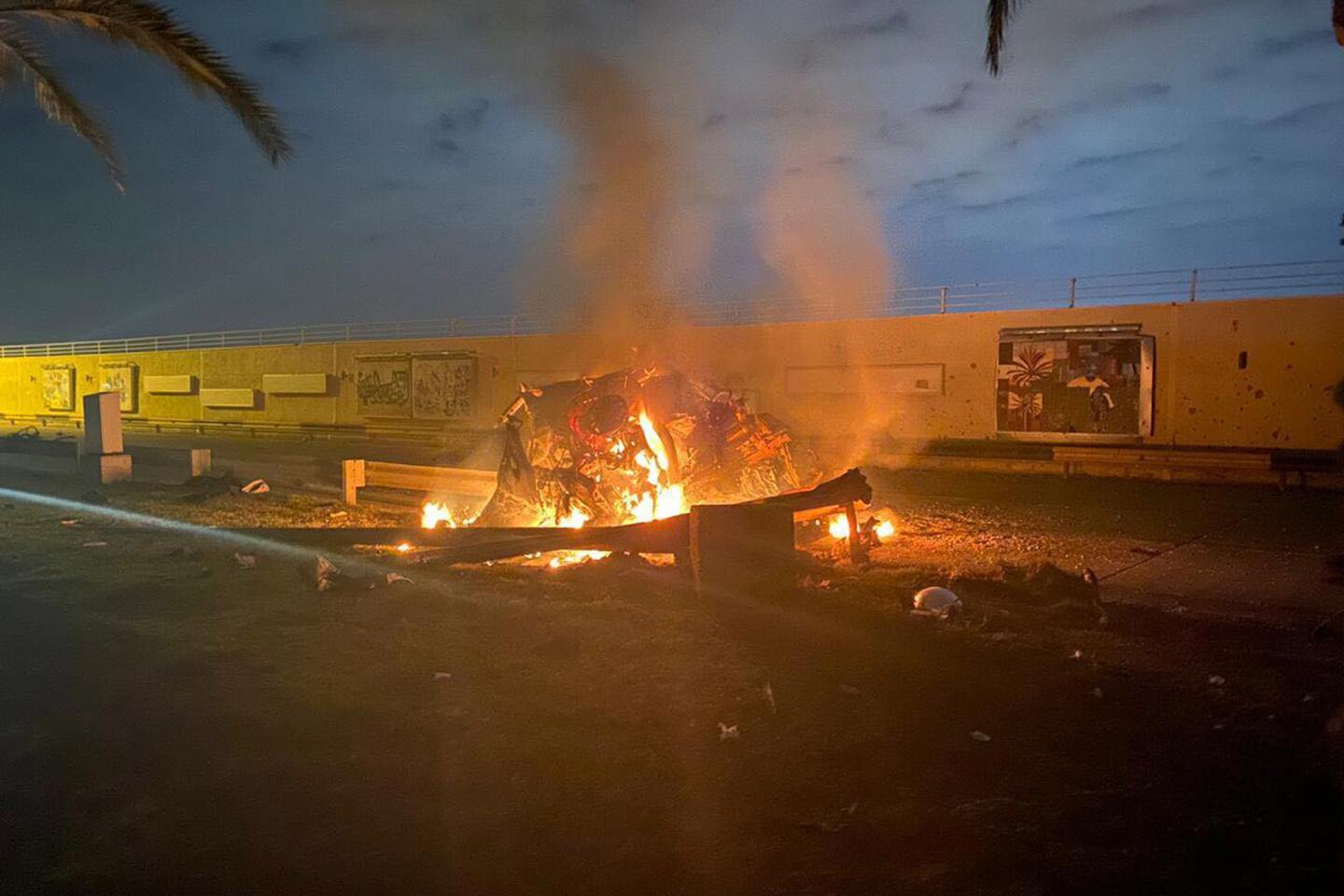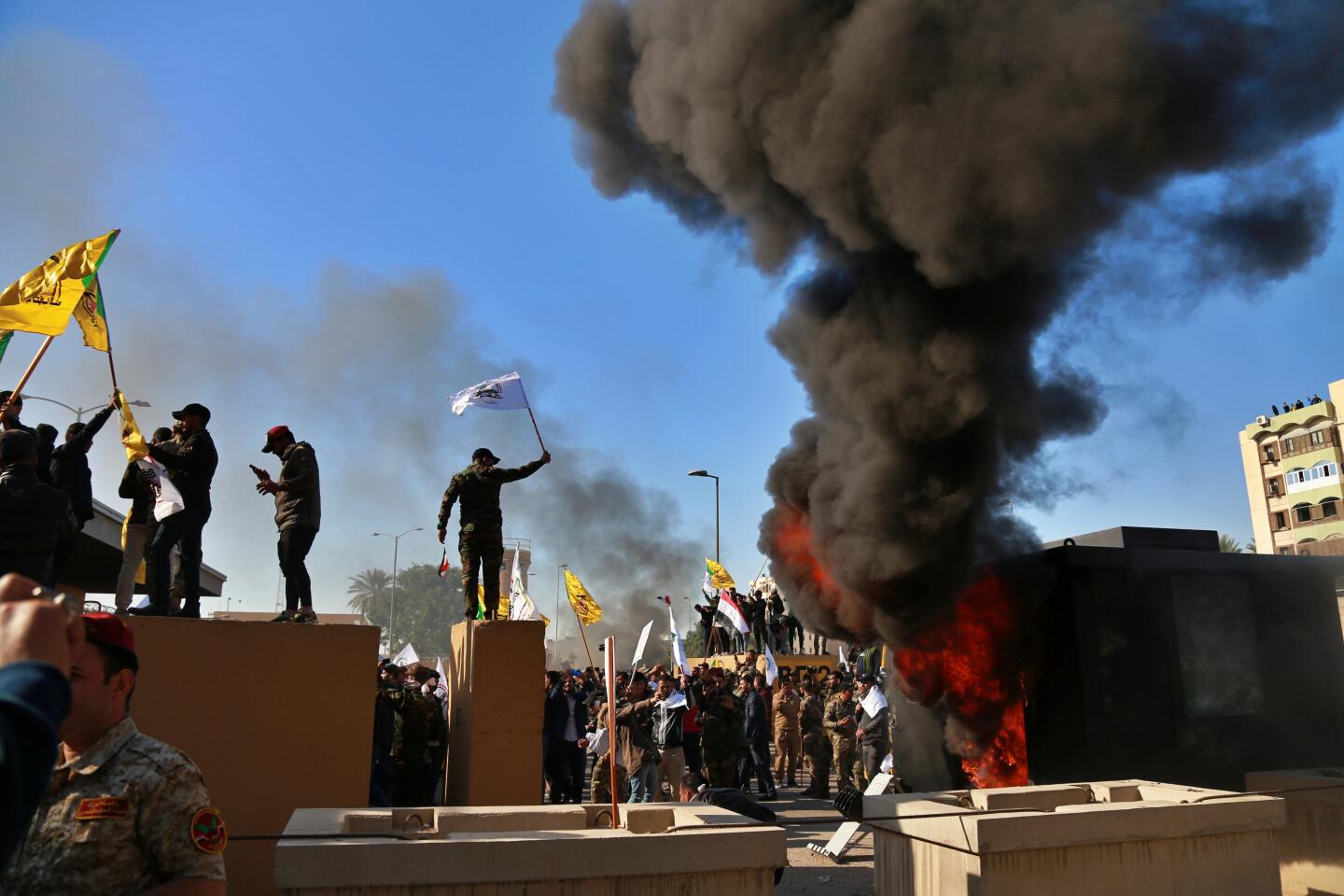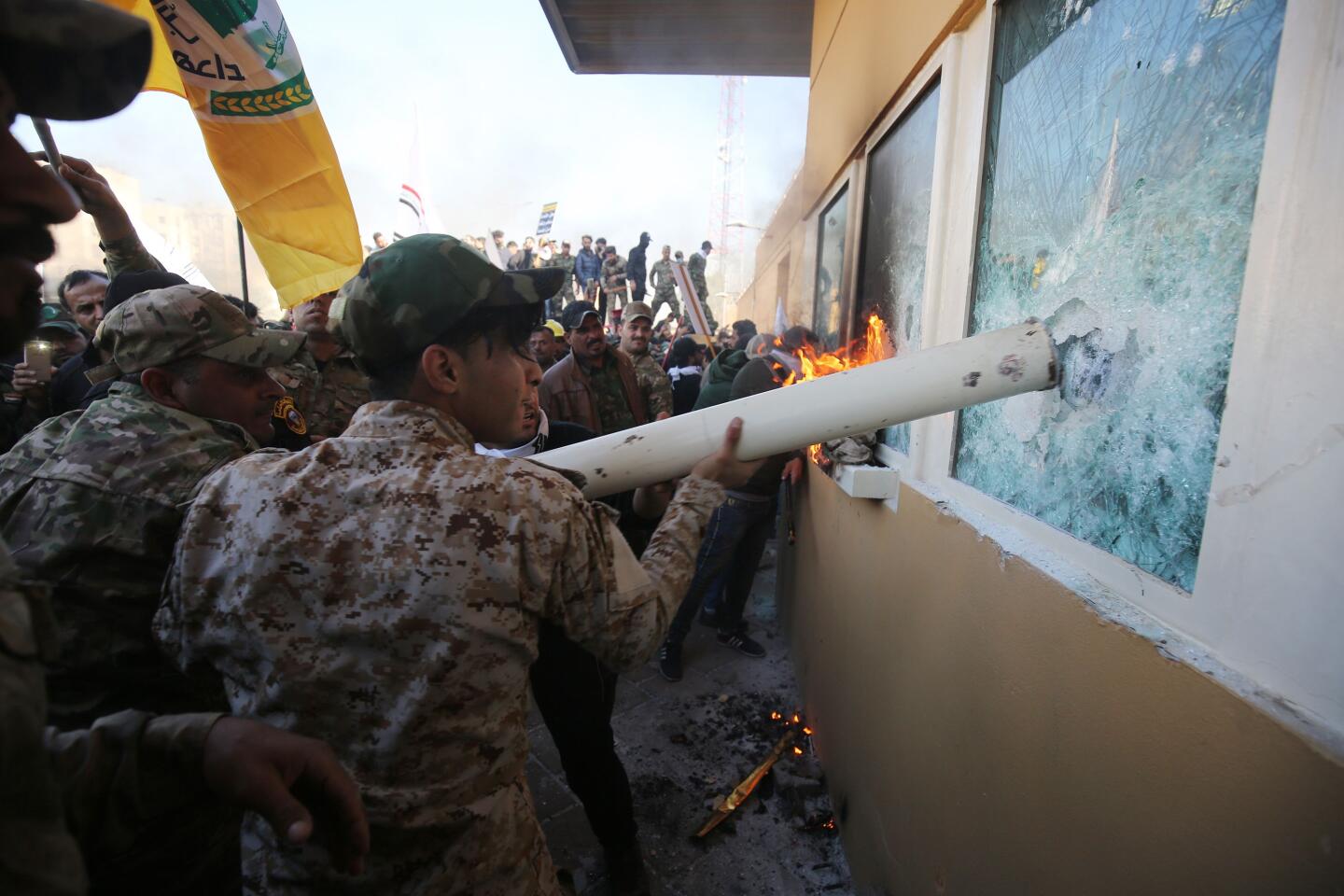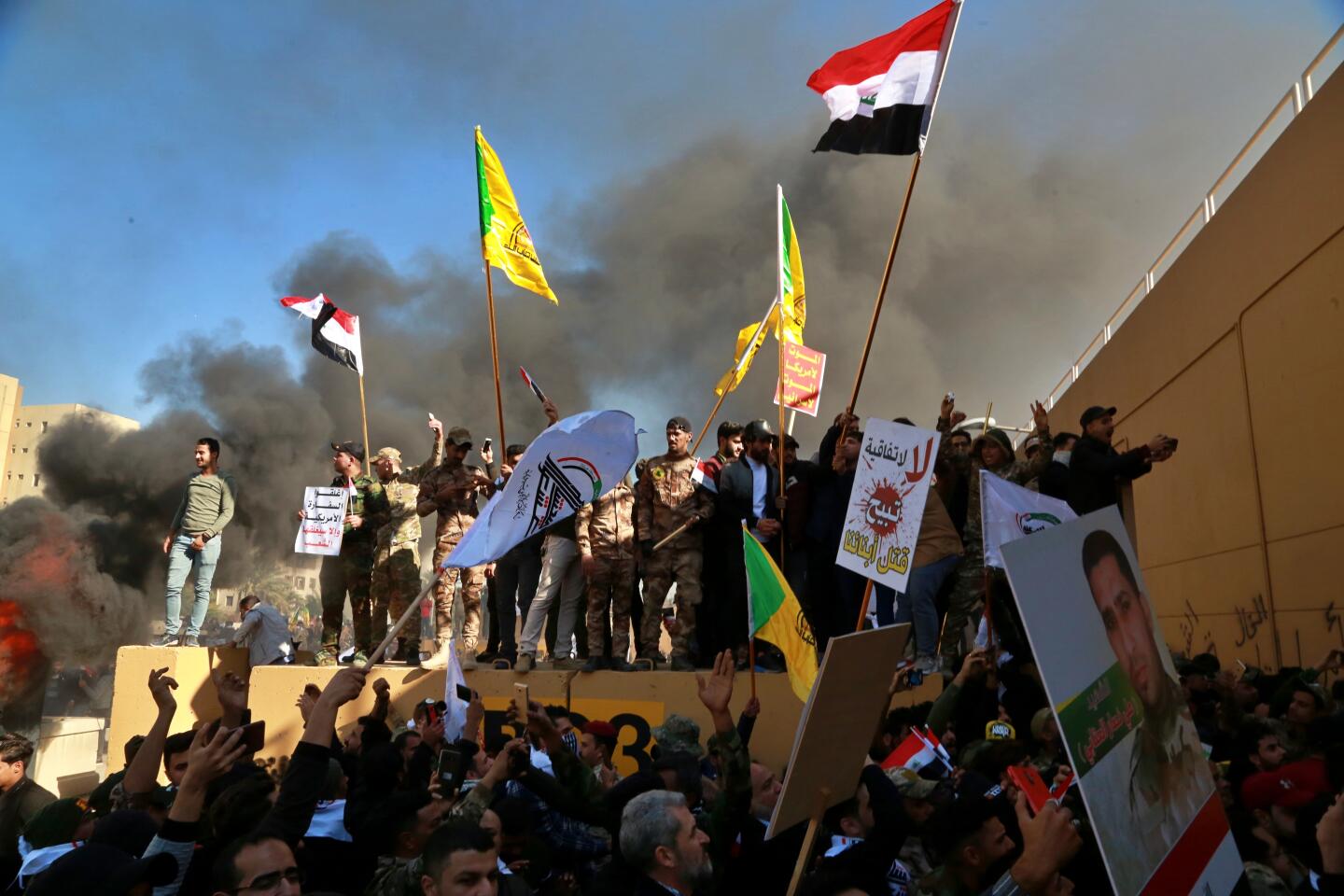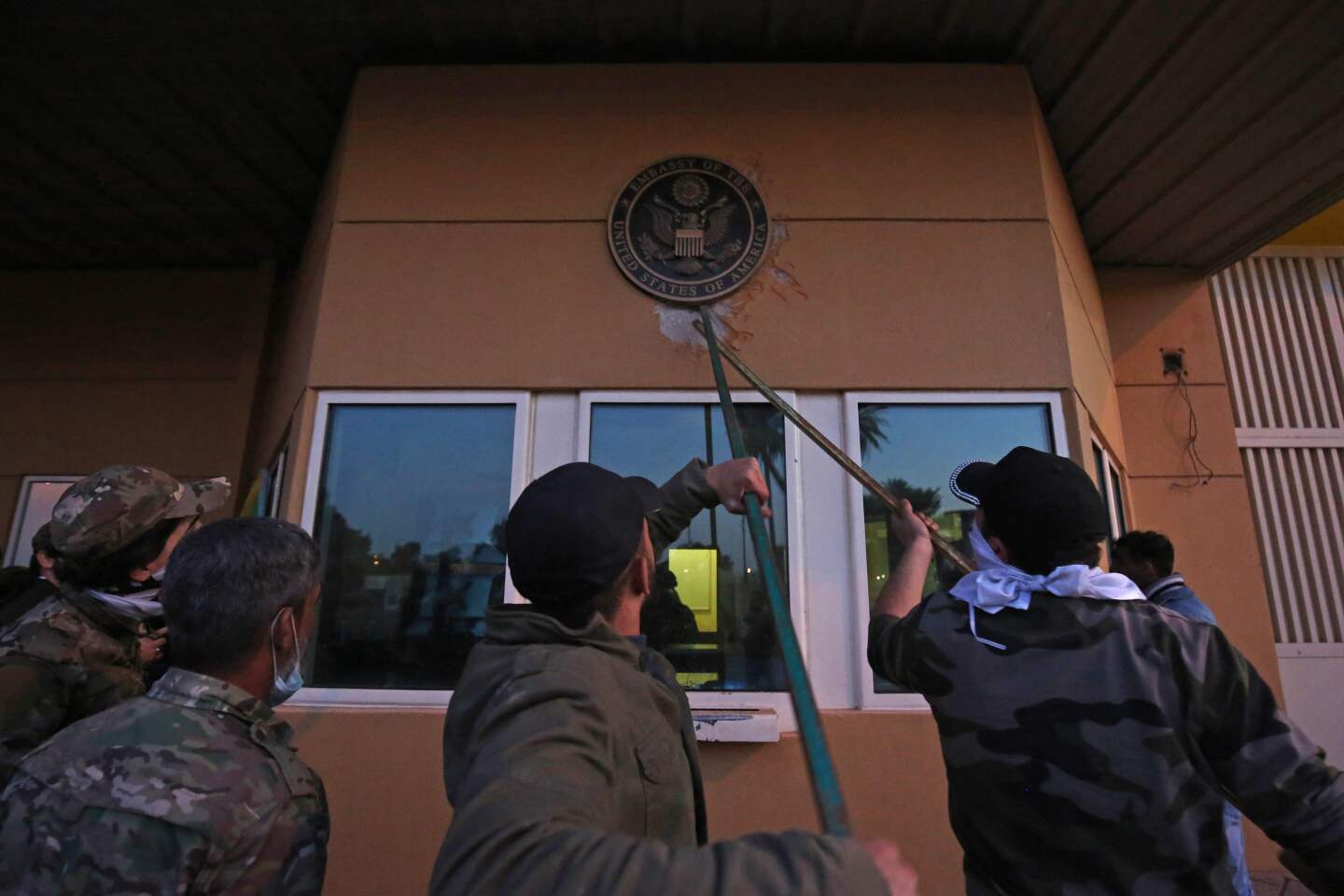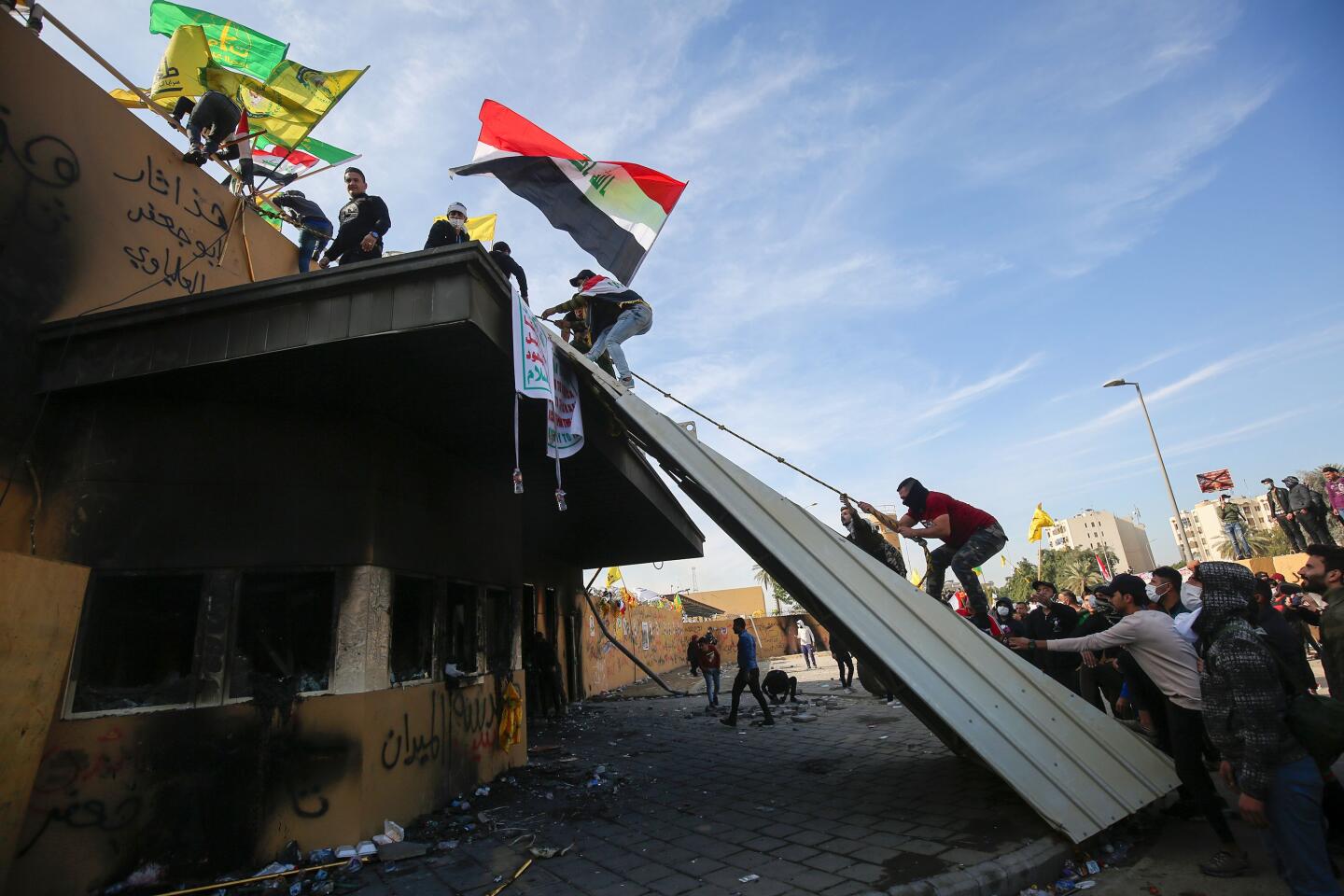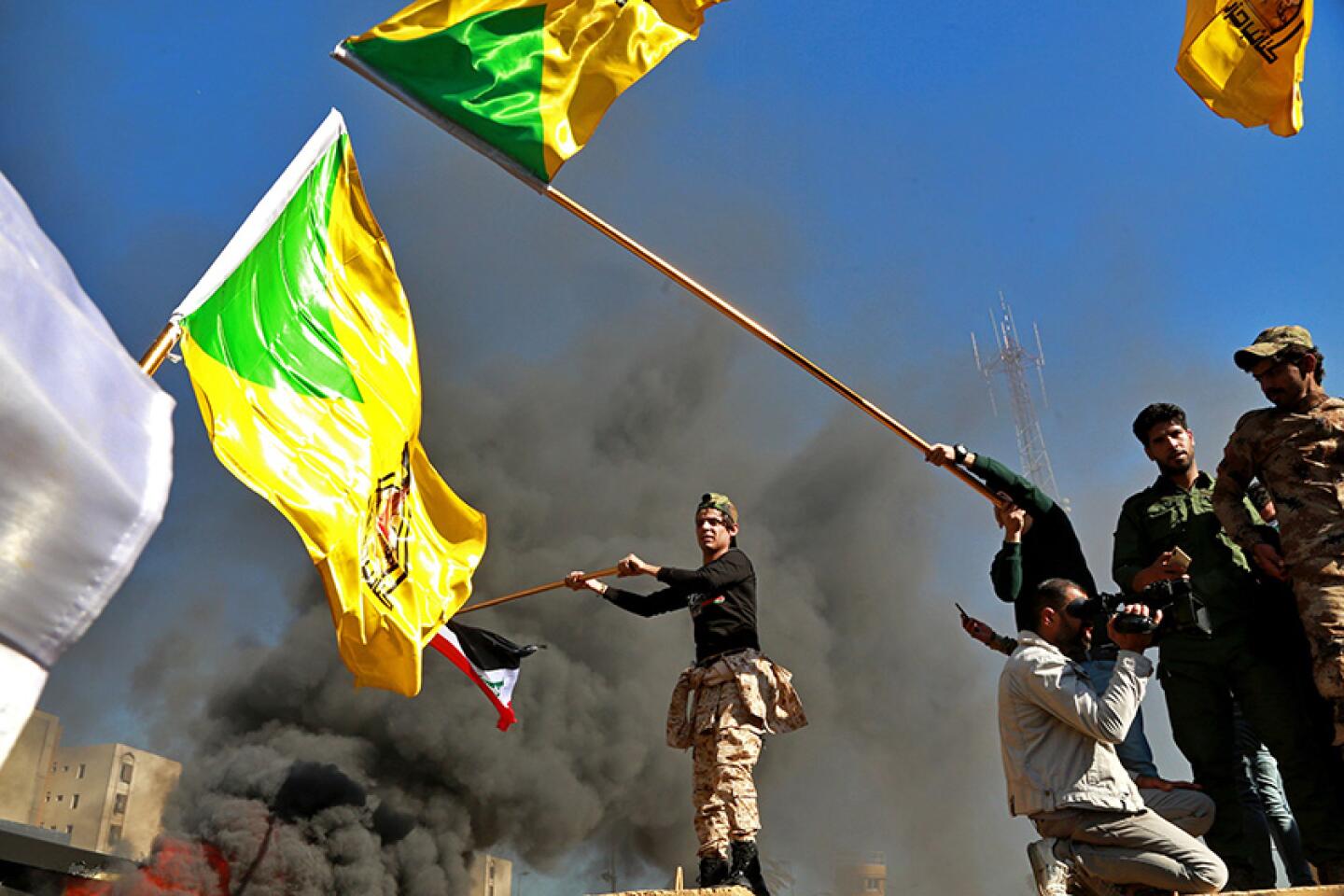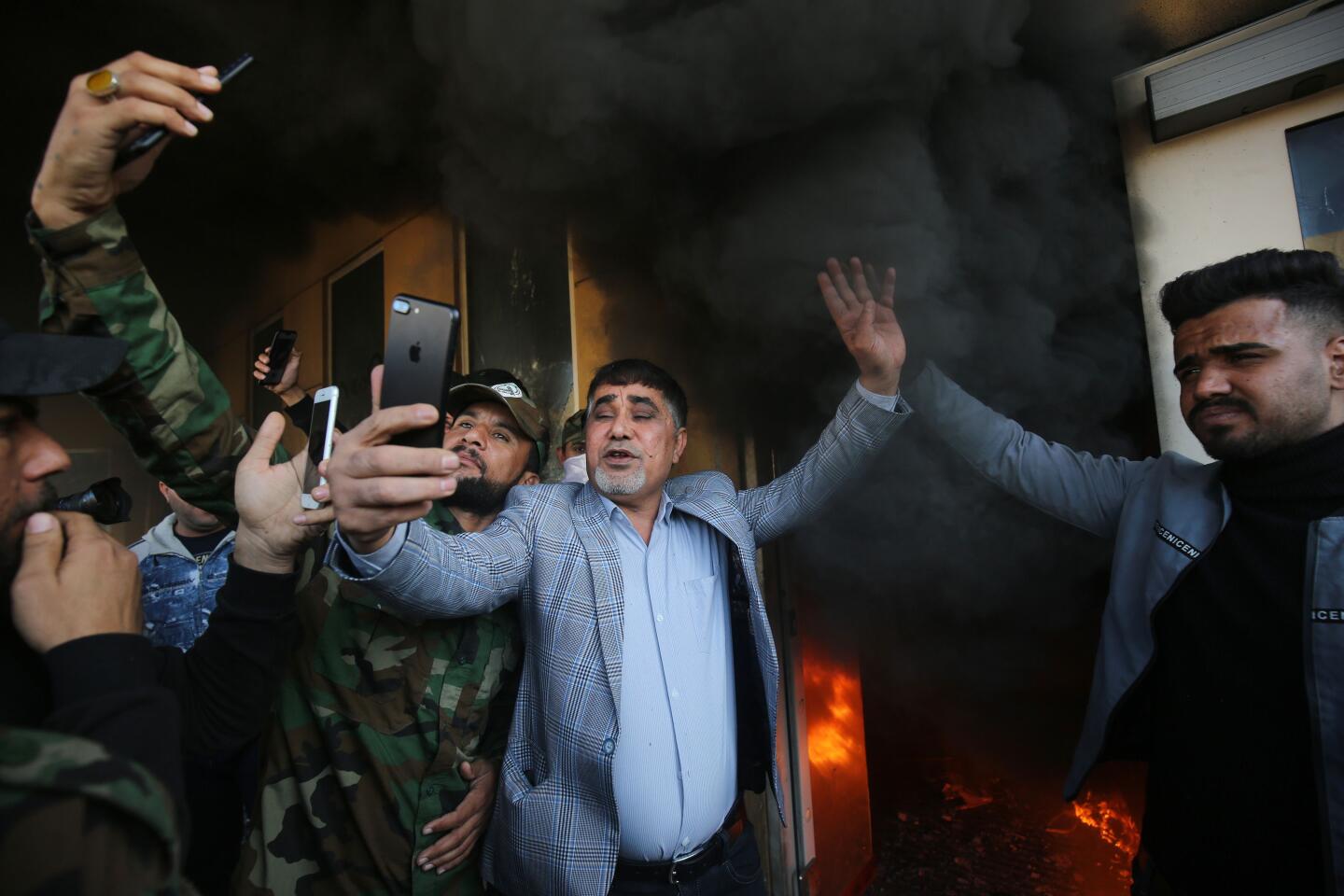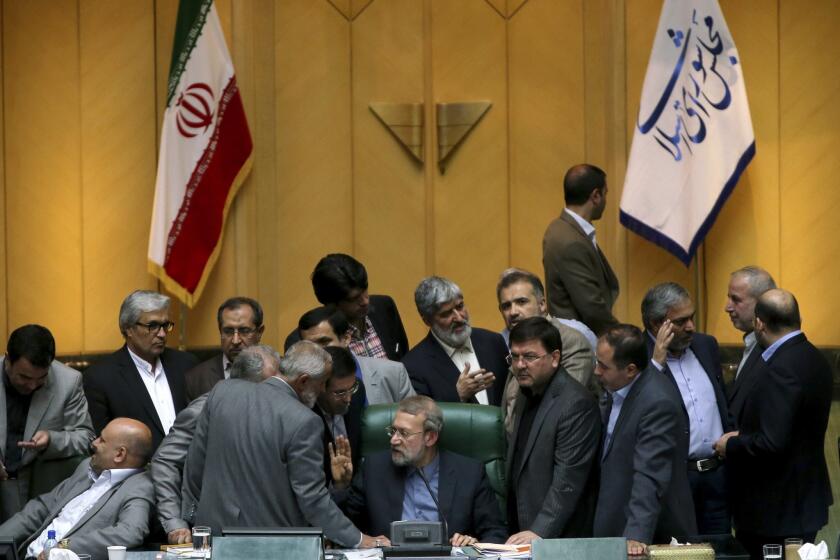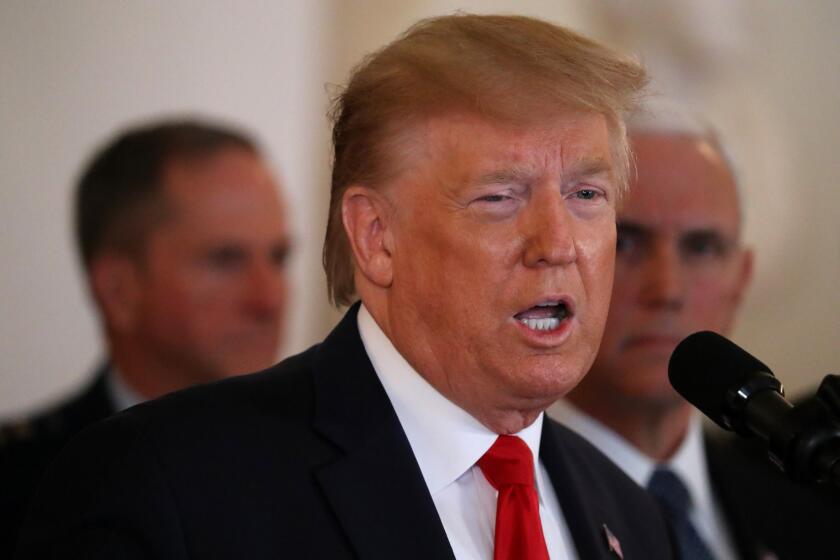Amid conflicting signals, Trump sends more Marines to the Middle East
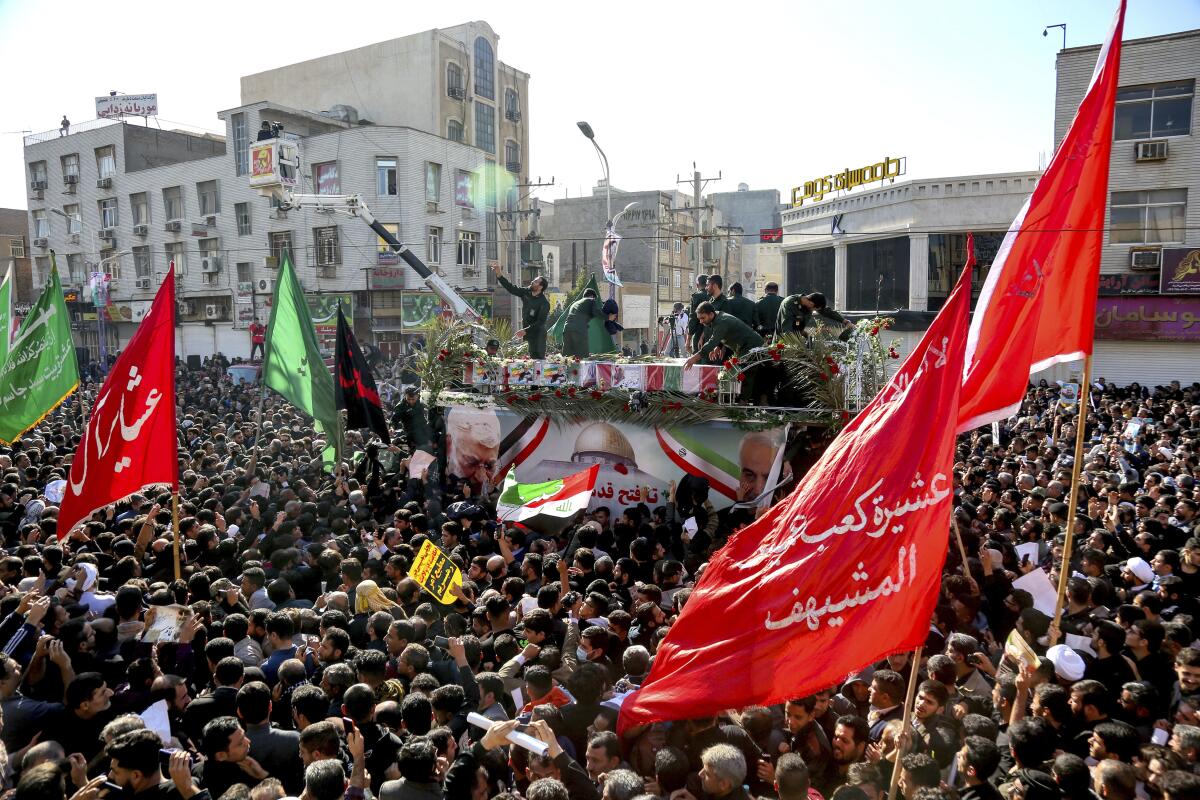
- Share via
WASHINGTON — The Pentagon moved Monday to send an additional 2,500 U.S. Marines to the Middle East, the latest fallout from President Trump’s order to kill a powerful Iranian general last week, but one that could increase the risk of the kind of grinding conflict that the president has vowed to avoid.
The reinforcements, now aboard ships headed to the Persian Gulf, were disclosed on a day of confusing signals and fast-moving events after a U.S. commander in Baghdad wrote to the Iraqi military saying preparations would be made to withdraw U.S. forces following a nonbinding decision by the Iraqi parliament to expel American troops.
Although the letter from Marine Brig. Gen. William H. Seely III was authentic, the Pentagon later said it was a draft that should not have been released, insisting that no final decision had been made.
Adding to the sense of disarray in policy, Secretary of Defense Mark Esper sought to defuse a growing international furor over Trump’s threats to attack Iranian cultural sites, saying U.S. forces would not do so.
Speaking to reporters at the Pentagon, Esper said cultural heritage sites with no military value are protected by international rules of war, and deliberately targeting them would be a war crime.
“We will follow the rules of armed conflict,” Esper said. Asked if that ruled out targeting cultural sites, Esper agreed, saying, “That’s the law of armed conflict.”
Esper pushed back against Trump’s threats a day after the Pentagon announced it was suspending offensive operations against the Islamic State terrorist group in Iraq — the chief justification for keeping 5,200 combat troops and contractors in the country — to focus on protecting its bases from potential Iranian attacks.
Although the president has bragged about eliminating Islamic State, which once controlled large parts of Iraq and Syria, the latest clash with Iran may create new openings for a resurgence of the extremist militant group.
The uncertainty over the prospect of a U.S. withdrawal — and the parameters of a possible U.S. attack — did little to reassure U.S. national security and foreign policy experts, who worry that Trump and his small group of hawkish advisors may miscalculate and blunder into another war — despite the president’s eagerness to disengage from the Middle East.
“The process so far has seemed pretty ragged,” said Eric Edelman, a former undersecretary of Defense under President George W. Bush.
The Iraqi parliament voted Sunday to expel U.S. forces in a mostly symbolic decision, leading to the Marine general’s letter saying that U.S. forces would be relocated “to prepare for onward movement” and that “we respect your sovereign decision to order our departure.”
Esper told reporters that the U.S. is not pulling troops out of Iraq, although he said some have been repositioned.
“There’s been no decision whatsoever to leave Iraq,” he said, adding, “there’s no decision to leave, nor did we issue any plans to leave or prepare to leave.” He said the U.S. remains committed to the campaign to defeat the Islamic State group in Iraq and the region.
After the parliament’s vote, Trump threatened to impose stiff sanctions on Iraq if it actually expelled U.S. troops, even though he’s often talked about pulling out of the country that a U.S.-led force invaded in 2003.
“He’s just reacting; he’s not thinking deeply about any of this,” Edelman said. “And this is where the hollow structure of the Trump administration is coming back to haunt them, and it makes you a little nervous about whether they’ve prepared for the consequences.”
Vast throngs of Iranians have poured into the streets to mourn the death of Gen. Qassem Suleimani, who led Iran’s elite Quds Force and was the architect of Tehran’s support for Shiite Muslim militias across Iraq, Lebanon, Syria and Yemen.
Suleimani, who was arguably the second most powerful figure in Iran, was killed in a U.S. drone strike early Friday in Iraq as he was departing Baghdad’s airport with the leader of a local Iranian-backed militia.
Senior administration officials — including Esper, Secretary of State Michael R. Pompeo, Chairman of the Joint Chiefs Mark Milley and CIA Director Gina Haspel — will brief the heads of congressional intelligence and armed services committees on Tuesday, and the full House on Wednesday about the intelligence and policy considerations that convinced Trump to authorize the drone strike.
“He should have been taken out a long time ago,” Trump told Rush Limbaugh, the conservative radio host, on Monday. “And we had a shot at it, and we took him out. We’re a lot safer now because of it.”
The 2,500 Marines are part of an amphibious readiness group that includes an assault ship resembling a small aircraft carrier, according to defense officials who were not authorized to speak publicly. Two other Navy vessels, an amphibious transport dock ship and a dock landing ship, are part of the flotilla.
Iran’s announcement that it will no longer abide by the most important limits in the landmark 2015 nuclear deal could place Tehran back on the pursuit of nuclear weapons.
The warships are headed toward the Persian Gulf and could transit the Suez Canal within days, the officials said, entering a region where the Pentagon has already dispatched a 4,000-soldier brigade from the 82nd Airborne Division.
An unknown number of special operations troops are there in case Iran or its proxies launch attacks or violent protests against U.S. bases or interests.
Iran launched a series of missile attacks aimed at bases in Iraq.
On Capitol Hill, House Speaker Nancy Pelosi (D-San Francisco) pushed a resolution that would limit Trump’s ability to wage war against Iran. If it passes, it would force the administration to cease hostilities within 30 days unless Congress authorized more action.
The resolution is certain to pass the Democratic-controlled House, but it’s unclear whether the Republican-controlled Senate would agree to limit the president’s options in a foreign policy crisis.
“Last week, the Trump administration conducted a provocative and disproportionate military airstrike targeting high-level Iranian military officials,” Pelosi said in a letter to House colleagues Sunday. “This action endangered our service members, diplomats and others by risking a serious escalation of tensions with Iran.”
Iran is vowing to strike back at the United States, although it’s unclear when or how.
“God the Almighty has promised to take martyr Suleimani’s revenge. Certainly actions will be taken,” said Gen. Esmail Ghaani, the new commander of the Quds Force, according to Reuters.
Although Trump initially said he had targeted Suleimani to prevent a war, Trump vowed in a tweet Sunday to “quickly & fully strike back, & perhaps in a disproportionate manner” if Iran attacks U.S. personnel. He said the U.S. had targeted 52 Iranian sites “some at a very high level and important to Iran and the Iranian culture, and those targets and Iran itself, will be hit very fast and very hard.”
Analysts said attacks on cultural sites could be considered war crimes under the Geneva Conventions, and questioned his strategy of ratcheting up his rhetoric if the goal is to lower the risk of war.
“It’s a delicate thing when you’re trying to deter an adversary,” said Jon Alterman, a Middle East expert at the nonpartisan Center for Strategic and International Studies in Washington. “You want to leave them a pathway to do what you want them to do.”
Recent history has shown that Tehran has tended to respond to U.S. military attacks in a calibrated, measured way, given the obvious power imbalance between the two countries.
“If you are the world’s most powerful country, your leader has more room to make mistakes,” said Ian Bremmer, president of the Eurasia Group, a global risk assessment firm. “Trump makes plenty of mistakes, but people are going to give him a wider berth because if the U.S. gets it wrong, it doesn’t affect us all that much. If Iran gets it wrong, it could be the end of their country.”
Luke Coffey, director of the Allison Center for Foreign Policy Studies at the Heritage Foundation, a Washington think tank, said he does not expect the increase in tensions to lead to war.
“Americans don’t want it. Trump doesn’t want it. The Iranians definitely don’t want it,” he said.
Times staff writer Sarah D. Wire contributed from Washington, and Times staff writer Nabih Bulos contributed from Baghdad.
More to Read
Get the L.A. Times Politics newsletter
Deeply reported insights into legislation, politics and policy from Sacramento, Washington and beyond. In your inbox twice per week.
You may occasionally receive promotional content from the Los Angeles Times.
